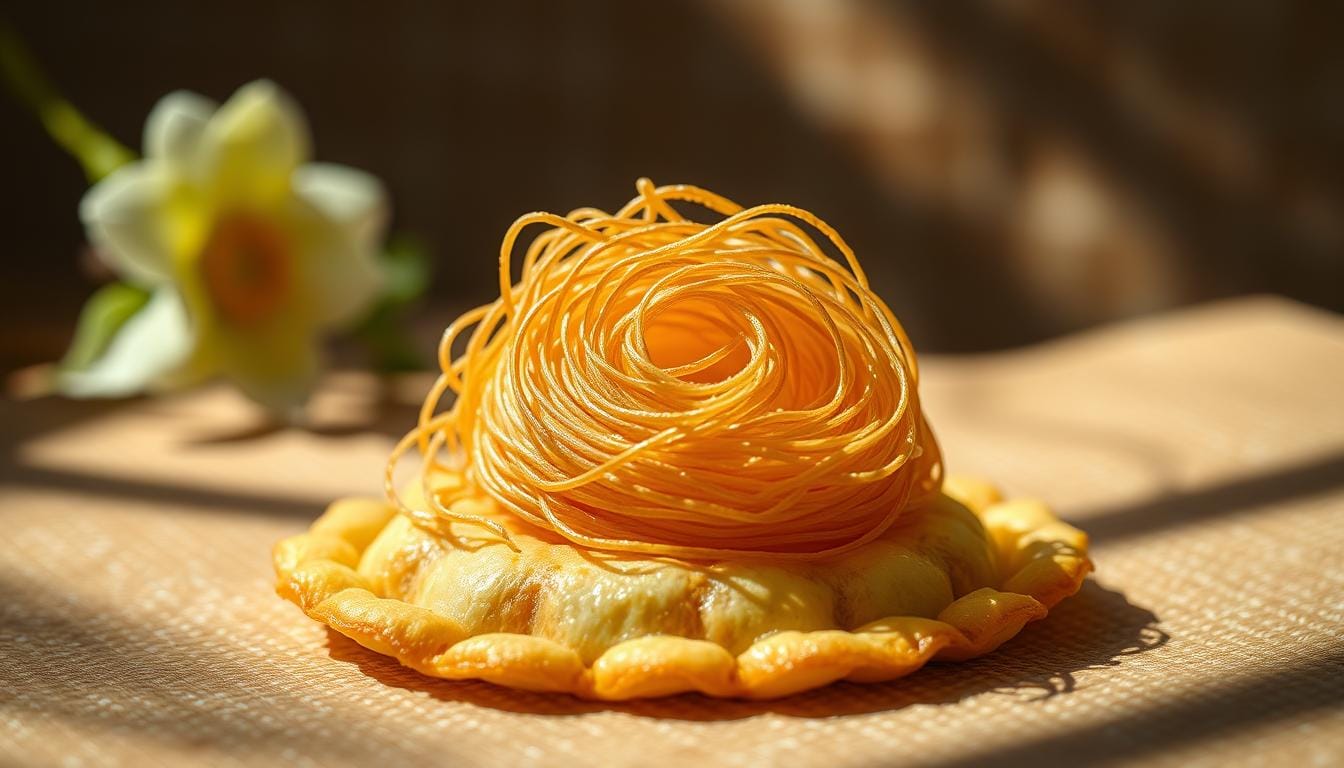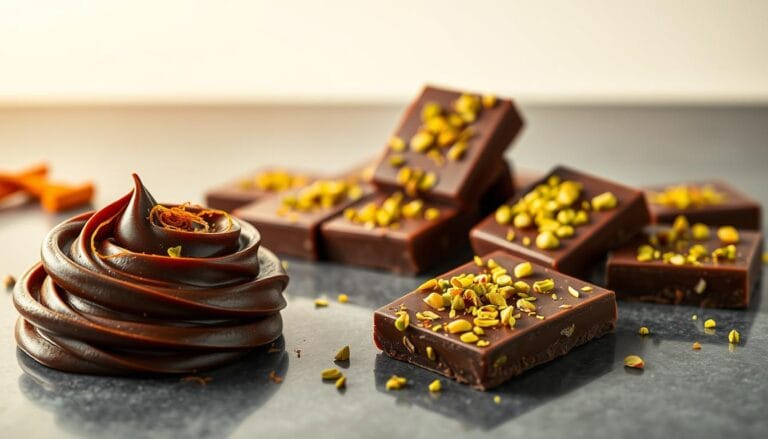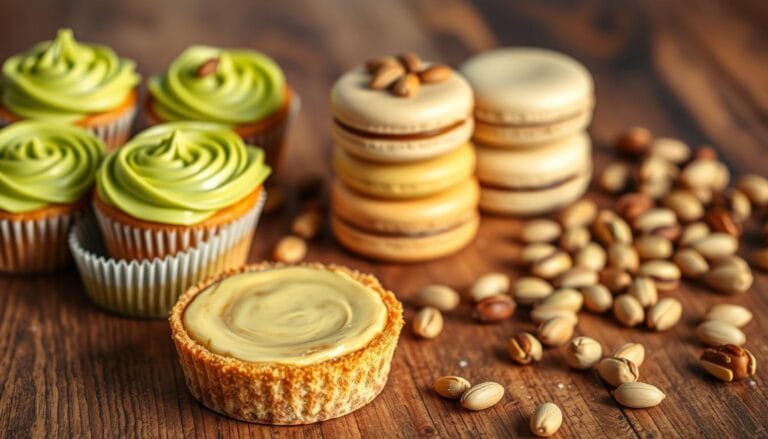Kataifi Pastry: A Flaky, Crispy Greek Delight
Imagine biting into a golden nest of crunchy strands that shatter delicately, releasing sweet honey notes and toasted nut aromas. This is the magic woven by one of the Mediterranean’s best-kept secrets – a culinary treasure that turns simple ingredients into pure delight.
Born from centuries of Middle Eastern tradition, this shredded dough carries stories of Ottoman kitchens and family gatherings. Its thin, thread-like layers create a textural wonder unlike any other – crisp yet tender, light but substantial. Whether cradling pistachios in syrup or embracing savory cheeses, it transforms everyday recipes into showstoppers.
Modern chefs love its versatility. From viral Dubai chocolate rolls to Greek dessert shops, it’s having a global moment. But here’s the secret: you can master it at home. No fancy tools needed – just patience and passion for that perfect balance of crunch and melt-in-your-mouth softness.
This guide unlocks everything from its rich history to pro baking tips. You’ll discover why this ingredient deserves a permanent spot in your kitchen, whether you’re crafting weekend treats or impressing dinner guests. Ready to create edible lace that dances between crisp and tender?
Introduction to Kataifi Pastry and Its Greek Heritage
The art of crafting shredded dough dates back to Ottoman kitchens, where bakers perfected thread-like strands through meticulous hand-stretching. This technique traveled across the Mediterranean, evolving into a cornerstone of Greek celebrations and family recipes.
Exploring the Origins and Tradition
Centuries-old methods transformed simple flour mixtures into edible lace. Skilled artisans passed down secrets for rolling layers thin enough to see through – a process requiring both precision and patience. Coastal villages added citrus notes to syrup-soaked desserts, while mountain regions incorporated wild herbs into savory versions.
The Versatility of a Timeless Delight
One batter creates endless possibilities. Try these crowd-pleasers:
- Sweet: Layer honey-drenched strands with pistachios for a baklava twist
- Savory: Wrap feta-stuffed bundles for crispy appetizers
Turkish Ekmek Kadayıfı proves its adaptability – bread-like bases soak up rose syrup before getting crowned with cream. The Greek version swaps bread for golden dough nests, pairing them with vanilla custard and crushed pistachios.
Modern recipes keep this tradition alive. Chefs stuff shredded layers with everything from spiced lamb to dark chocolate, proving its role in both time-honored dishes and contemporary fusion plates.
Mastering kataifi pastry: Tips and Techniques
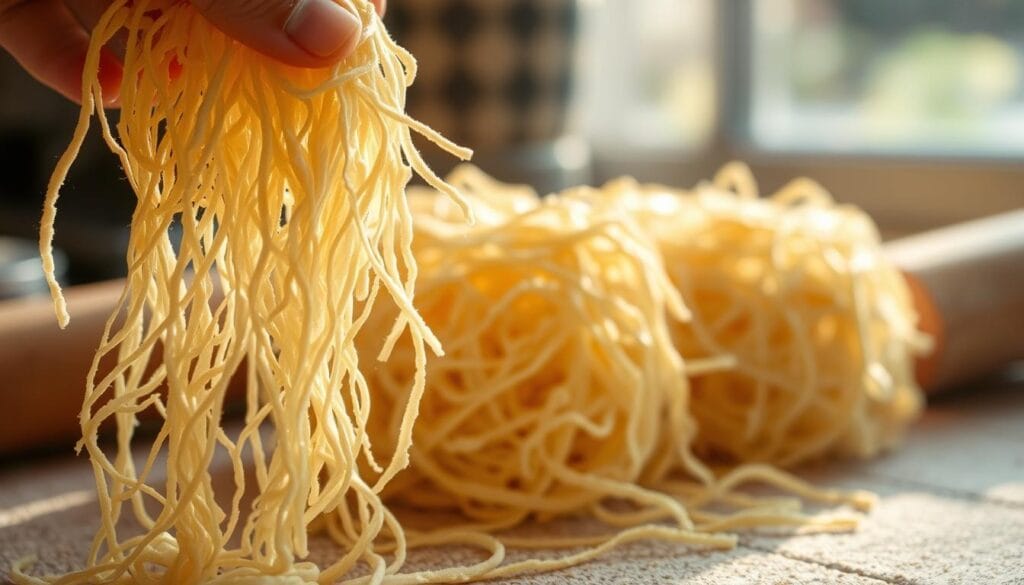
Creating delicate golden strands might seem daunting, but modern methods make it accessible. Whether you’re craving honey-drenched desserts or viral Dubai chocolate creations, homemade versions offer unmatched quality and creativity.
Why Craft It Yourself?
Store-bought options often cost $25+ for basic ingredients worth $3. Rural bakers face limited access to specialty stores. Homemade strands stay fresh longer and let you adjust thickness for specific recipes.
| Factor | Store-Bought | Homemade |
|---|---|---|
| Cost | $18-$28 | $2-$4 |
| Availability | Limited | Always on-hand |
| Freshness | 2-week shelf life | 3 months frozen |
| Customization | Fixed texture | Adjustable thickness |
Simplified Success
Our recipe uses pantry staples: flour, cornstarch, and water. The key lies in resting the batter and using a squeeze bottle for perfect strands. Freeze batches for future Dubai chocolate experiments or last-minute desserts.
One baker shared: “I finally made baklava that rivals my grandmother’s – the fresh strands absorbed syrup better than store versions.” This guide breaks techniques into 15-minute stages, making intricate desserts achievable between work calls.
Essential Ingredients and Equipment for Homemade Kataifi
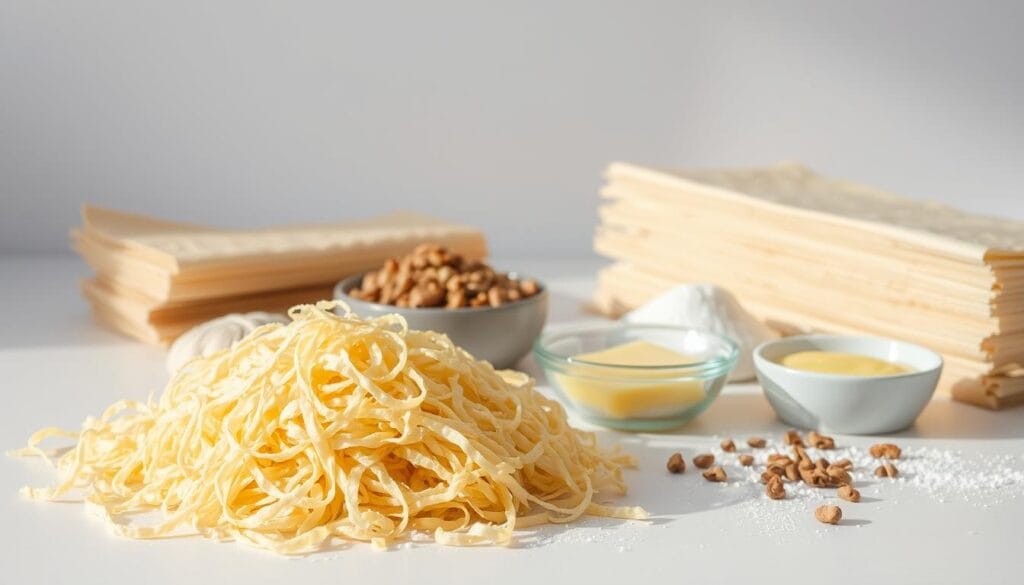
The foundation of perfect shredded dough lies in precise ingredient ratios and smart tool choices. Let’s break down what transforms basic pantry items into golden, lace-like strands.
Key Ingredients: Flour, Cornstarch, and More
All-purpose flour forms the backbone – its gluten content creates structure without toughness. Paired with cornstarch, it delivers that signature crisp-tender balance. “The cornstarch acts like a secret weapon,” notes Athenian baker Eleni Vasiliou. “It prevents chewiness while letting flavors shine.”
A teaspoon of sugar accelerates browning, while salt amplifies flavor complexity. Vegetable oil ensures layers separate cleanly during cooking. Use lukewarm water to activate proteins gradually – cold liquid makes batter stubborn.
Must-Have Kitchen Tools and Setup
Three essentials dominate:
- Digital scale: Measures flour accurately (cups vary wildly)
- Silicone piping bag: Creates uniform strands without bursts
- Non-stick pan: Prevents sticking during delicate cooking
While a bowl and whisk work for mixing, sieving dry ingredients eliminates lumps. A sturdy spatula scrapes every bit of batter – waste nothing when perfection’s at stake.
| Tool | Purpose | Budget Option |
|---|---|---|
| Kitchen scale | Precise measurements | Repurposed postal scale |
| Squeeze bottle | Strand control | Clean ketchup bottle |
| Pastry brush | Oil application | Folded paper towel |
Step-by-Step Guide to Making Kataifi Batter
The secret to golden, lace-like strands begins with mastering the batter. This foundation determines whether your creation becomes crispy perfection or chewy disappointment. Let’s transform simple ingredients into a silky-smooth base ready for piping.
Mixing Dry and Wet Ingredients
Start with a medium bowl. Combine flour, cornstarch, sugar, and salt. Whisk vigorously for 30 seconds – this aerates the mixture and prevents clumping. Slowly drizzle in oil while stirring, creating tiny pockets of fat for flakiness.
Add lukewarm water in three stages. The batter should thicken slightly with each addition. “Stop when it ribbons off the whisk,” advises pastry chef Maria Thanou. “Overmixing activates gluten, making strands tough.”
Achieving the Perfect Batter Consistency
Test your batter by lifting a spoonful. It should flow smoothly like heavy cream but coat the back of a spoon. Sieve the mixture to catch stubborn lumps that could clog your piping tip.
Too thick? Add water ½ tsp at a time. Too runny? Sprinkle flour while whisking. Remember: Proper consistency means strands hold shape without becoming brittle. Your final test? It should pour like warm honey but set quickly on a hot pan.
Shaping, Cooking, and Piping the Kataifi Pastry
Your pan becomes an artist’s canvas when working with this delicate dough. Mastering temperature control transforms simple batter into lace-like creations that snap with each bite. Let’s break down the techniques that turn kitchen experiments into golden masterpieces.
Cooking Techniques for Crispy, Golden Strands
Heat a non-stick pan over low heat – test it by flicking water droplets. They should dance, not sizzle violently. Squeeze your piping bag in swift zig-zag motions, leaving space between strands. Watch them turn golden in 5-8 seconds as proteins set instantly.
Remove pieces quickly with a thin spatula. Overcooked strands lose flexibility – they should bend slightly before hardening. Pro tip: Rotate the pan to distribute heat evenly. Uneven browning often means your burner needs adjustment.
Piping Bag Tips and Alternatives
Cut the bag’s tip smaller than you think – start with pinhole size. For uniform strands, maintain steady pressure while moving your hand in fluid motions. No specialty tools? Use a ziplock bag with a snipped corner or repurpose a clean condiment bottle.
Struggling with clogs? Sieve your batter twice. If strands merge on the pan, reduce piping speed. Practice on parchment paper first to build muscle memory. As baker Lina Karas shares: “Consistency beats speed – rhythm matters more than rushing.”
Enhancing Flavor: Creative Sweet and Savory Ideas
Transform ordinary desserts into showstoppers by layering textures and cultural influences. Whether crafting honey-drenched classics or viral Dubai chocolate creations, your homemade strands become edible canvases for flavor experimentation.
Incorporating Middle Eastern and Greek Influences
Infuse tradition with every bite. Drizzle rose-orange syrup over baklava variations, or mix cardamom into nut fillings. Coastal Greek recipes often pair shredded layers with lemon zest custard, while Middle Eastern spices like mahleb add warmth to cheese-filled bundles.
Experimenting with Fillings and Toppings
Swap traditional nuts for chocolate-hazelnut spreads in heart-shaped knafeh. Crushed pistachios add crunch to brownie bases, and salted caramel balances sweet savory pies. For social media-worthy treats, layer melted Dubai chocolate between golden strands – its smooth richness contrasts beautifully with crispy textures.
Your creations will shine brightest when balancing heritage and innovation. Try dipping chocolate-drenched nests in edible gold dust, or stuff them with spiced lamb for appetizers. The possibilities? As endless as your imagination.

